
95% of researchers rate our articles as excellent or good
Learn more about the work of our research integrity team to safeguard the quality of each article we publish.
Find out more
ORIGINAL RESEARCH article
Front. Vet. Sci. , 23 August 2023
Sec. Animal Nutrition and Metabolism
Volume 10 - 2023 | https://doi.org/10.3389/fvets.2023.1238070
This article is part of the Research Topic Poultry Feeding, Nutrition, and Quality in the Post-Antibiotic Era View all 14 articles
 Mahmoud Mostafa Azzam1
Mahmoud Mostafa Azzam1 Wei Chen2
Wei Chen2 Weiguang Xia2
Weiguang Xia2 Shuang Wang2
Shuang Wang2 Yanan Zhang2
Yanan Zhang2 HebatAllah Kasem El-Senousey2,3
HebatAllah Kasem El-Senousey2,3 Chuntian Zheng2*
Chuntian Zheng2*Poultry requires Threonine, an essential amino acid, and its metabolites for proper metabolic function. Threonine is crucial in the biosynthesis of mucin, which is essential for intestinal health and nutrient absorption. Bacillus subtilis (B. subtilis) is a potential substitute for antibiotic growth promoters in the poultry industry. The current study was designed to evaluate the simultaneous effect of L-Threonine (Thr) and B. subtilis DSM32315 supplementation on laying duck breeders in order to maximize performance. A total number of 648 female 23-week-old Longyan duck breeders were assigned to a 3 × 2 factorial design with six replicates of 18 birds per replicate. L-Thr was added to the control diet at concentrations of 0, 0.7, and 1.4 g/kg, equating to 3.9, 4.6, and 5.3 g Thr/kg, with or without B. subtilis strain DSM 32315 (0.0 and 0.5 g/kg). Increasing Thr concentrations improved egg production and ducklings’ hatchling weight (p < 0.05). In addition, L-Thr supplementation resulted in a tendency for decreased feed conversion ratio without affecting egg quality. There was no significant effect (p > 0.05) of the dietary Thr levels on egg yolk and albumen amino acid concentrations. In contrast, the addition of B. subtilis decreased the concentrations of amino acids, excluding proline, in the egg white (albumen) and the egg yolk (p < 0.05). Furthermore, the supplementation of B. subtilis decreased (p < 0 0.001) the hatching weight of ducklings. The addition of B. subtilis without L-Thr decreased (p < 0.05) the hatchability of fertile eggs and the hatching weight of ducklings compared to those of ducks fed dietary L-Thr along with B. subtilis (p < 0.001). The combining L-Thr at 0.7 g/kg with B. subtilis DSM 32315 at 0.5 g/kg could increase eggshell quality, hatchability, and hatching weight. The current study revealed that the combination supplemented of L-Thr and B. subtilis DSM 32315 is recommended due to its positive effects on the eggshell percentage, hatchability and the body weights of newly hatched ducklings when dietary Thr was added at a rate of 0.7 g/kg and B. subtilis DSM 32315 at 0.5 g/kg. In addition, adding L-Thr separately at 0.7 g/kg could improve the egg production of duck breeders. Further studies are required to find the proper dosages of B. subtilis DSM 32315 with co-dietary inclusion of limiting amino acids in the diets of duck breeders. The findings of these trials will support feed additive interventions to transition into antibiotic-free diets.
The use of antibiotic growth promoters (AGP) has been banned in poultry farms worldwide. Therefore, global efforts in the poultry industry are focused on the development of effective feeding strategies that provide comparable benefits. Bacillus subtilis DSM 32315 has been effectively utilized as a substitute for AGP in broiler feeding (1–3). Bacillus subtilis DSM 32315 has unique beneficial effects on broilers; dietary supplementation of B. subtilis DSM 32315 improved the growth performance of birds and the intestinal microflora balance (4). The addition of B. subtilis to laying hens’ diets increased egg production, health, and egg quality’ (5, 6). Furthermore, the application of dietary B. subtilis (C-3102) improved the egg weight, fertility and hatchability, and eggshell thickness in laying hen breeders (7). Bacillus subtilis supplementation has a significant impact on the levels of a wide range of chemical metabolites in the chicken intestine, particularly those related to amino acids (8). Moreover, adding a probiotic to an amino acid supplement has been demonstrated to have a synergistic or additive effect on productivity, egg quality, and immunity (9). Therefore, the combination of Thr (an essential amino acid) and probiotic Bacillus may increase the absorptive area and functional ability of the intestine, thereby increasing production and egg quality.
Threonine is an essential amino acid for poultry because it is the third most limiting amino acid, and its metabolites are necessary for the metabolic process. Thr is essential for mucin biosynthesis, which is crucial for intestinal health and the absorption of nutrients. Previous research has demonstrated that Thr supplementation significantly increases egg production in laying ducks and breeder hens (10–12). However, previous studies mainly focused on the effects of supplementing B. subtilis DSM 32315 as a potential probiotic in diets as individual supplements. To our knowledge, no prior study has evaluated the combined effects of dietary Thr and B. subtilis on laying duck breeders, as far as we are aware. Consequently, this study aimed to investigate the interactive effects of dietary Thr and B. subtilis on laying duck breeders’ reproductive performance, the eggs’ amino acid composition, and early post-hatch duckling performance’.
In a randomized block design, six hundred and forty-eight of female Longyan duck breeders, with comparable body weight (1.10 ± 0.09 kg), 23 weeks old, were assigned to a 3 × 2 factorial design with 6 replicates pens containing 18 ducks and each duck was housed in one cage [18 ducks (cages)/ replicate]. Ducks were raised at 24°C and 74% RH during the experimental period. In addition, a 17-h photoperiod per d was adopted. The basal control diet met the requirements of the breed (Table 1). L-Threonine (L-Thr, 98.5%, ThreAMINO, Evonik Industries AG, Essen, Germany) was supplemented to the control diet at 0, 0.7, and 1.4 g /kg, corresponding 3.9, 4.6, and 5.3 g total Thr /kg with or without B. subtilis strain DSM 32315 0.0 and 0.5 g/kg, B. subtilis strain DSM32315 according to the manufacturer’s recommendation [min. 2 × 109 CFU/g (Gut Care® PY1; Evonik Industries AG, Essen, Germany)]. The dietary amino acids were analyzed using HITACHIL-8900 (Hitachi, Ltd., Tokyo, Japan) (Table 2) (13). The Animal Care Committee of Guangdong Academy of Agriculture Sciences (Guangdong, PRC) approved the study.
The number of eggs and feed intake for each replicate were recorded in order to calculate egg production and the feed conversion ratio (g feed intake/g egg produced). Each female breeder was inseminated (artificially) twice weekly with 100 L of pooled sperm at the age of 40 weeks. Fifty eggs from each replicate (n = 300 eggs per treatment) were incubated using an egg incubator under (Dezhou Jingxiang Technology Co, Dezhou, China) at 37.2°C to 38.0°C and 60 to 75% RH for 28 day. The fertility, hatchability, and ducklings’ weights were determined. Three eggs per replicate (n = 18 eggs per treatment) were collected at the end of the experiment to determine egg quality, as described by Ruan et al. (14). In addition, both albumen and yolk were extracted and kept at −20°C to determine amino acid content.
The albumen and yolk samples were dried to constant weight and then defatted and hydrolyzed. An amino acid analyzer (HITACHIL-8900, Hitachi, Ltd., Tokyo, Japan) was used according to the AOAC method 994.12 (15). Briefly, a hundred milligrams of each sample were mixed with 800 μLof 0.1 MHCl and the oxygen was expelled bypassing nitrogen into the ampoule. Then, 800 μL of hexane was added and mixed by vertexing for1min, and centrifuged at 22,000 × g for 5 min, and the lower layer was collected. After acid hydrolysis with 6 NHCl at 110°C for 20 h, the amino acid contents were measured, except for cysteine and methionine. Methionine and cystine were measured by acid oxidation before hydrolysis with 6 NHCl (16). The absolute concentration was determined from the peaks of the sample and standard by comparing the peak area obtained for each amino acid with the peak area of the amino acid standards.
At hatch, the total number of ducklings (n = 468) were assigned to the same dietary treatment groups (3 × 2 factorial design) for early post-hatch performance of ducklings. Each treatment group included six replicates of 13 ducklings. Ducklings were provided the same starter diets (Supplementary Table S1). Pens were supplied with water and feeders to provide ad libitum access to feed. On day 7 of age, body weight and feed consumption were determined, and mortality rates were recorded daily.
The data were analyzed with SPSS16.0 using a 3 × 2 factorial experimental design that included 2 factors: L-Thr (0, 0.7, and 1.4 g/kg) and B. subtilis strain DSM 32315 (0.0 and 0.5 g/kg) in order to determine the effects of dietary Thr and probiotic B. subtilis and their interaction on the reproductive performance of laying duck breeders, the amino acid composition of eggs, and early post-hatch duckling performance. A two-way ANOVA (SPSS 16; SPSS Inc., Chicago, IL) and Tukey’s multiple comparisons were performed to compare means. The a and b superscripts refer to a significant difference (p < 0.05), and * indicates a tendential difference between treatments at a specific time point (p = 0.051 ~ 0.06).
The productive performance data are shown in Table 3. Increasing the L-Thr levels increased egg production rate compared with those of birds fed the control diet (66.22 ± 0.02 (0.7 g Thr /kg) and 66.14 ± 0.02% (1.4 g Thr /kg) VS 54.78 ± 0.02% (0.0 g Thr /kg); p < 0.05). The addition of B. subtilis did not affect the laying performance. Thr and probiotic (B. subtilis) co-supplementation had no effect on laying performance (p > 0.05).
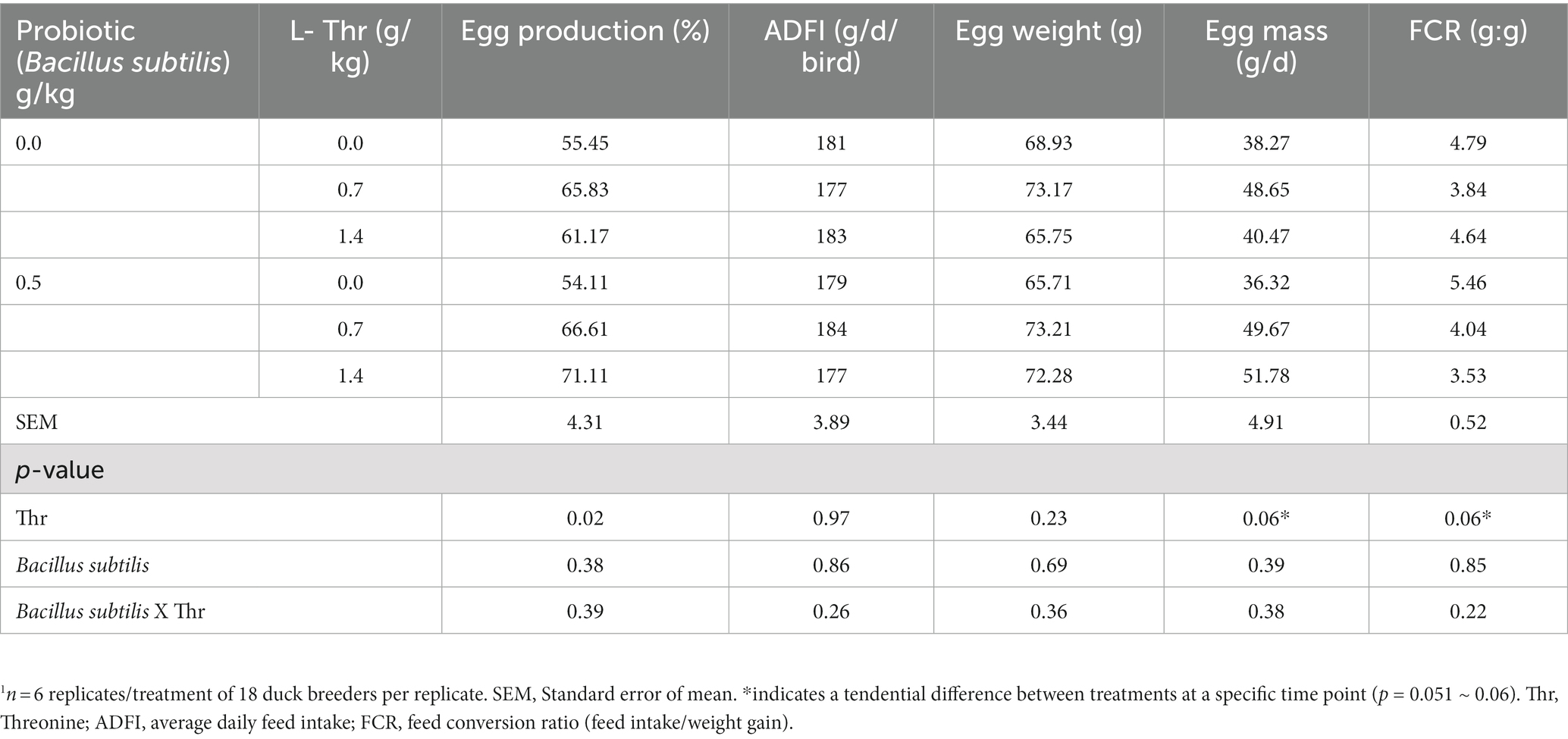
Table 3. Effect of dietary L-Thr levels and Bacillus subtilis addition on laying performance of laying duck breeders from week 23 to 48 of age1.
The results of egg quality are depicted in Table 4. Both Thr and B. subtilis demonstrated no significant effect on (p > 0.05) albumen height, Haugh unit, eggshell thickness, eggshell strength, or percentage of albumen, yolk, and eggshell.
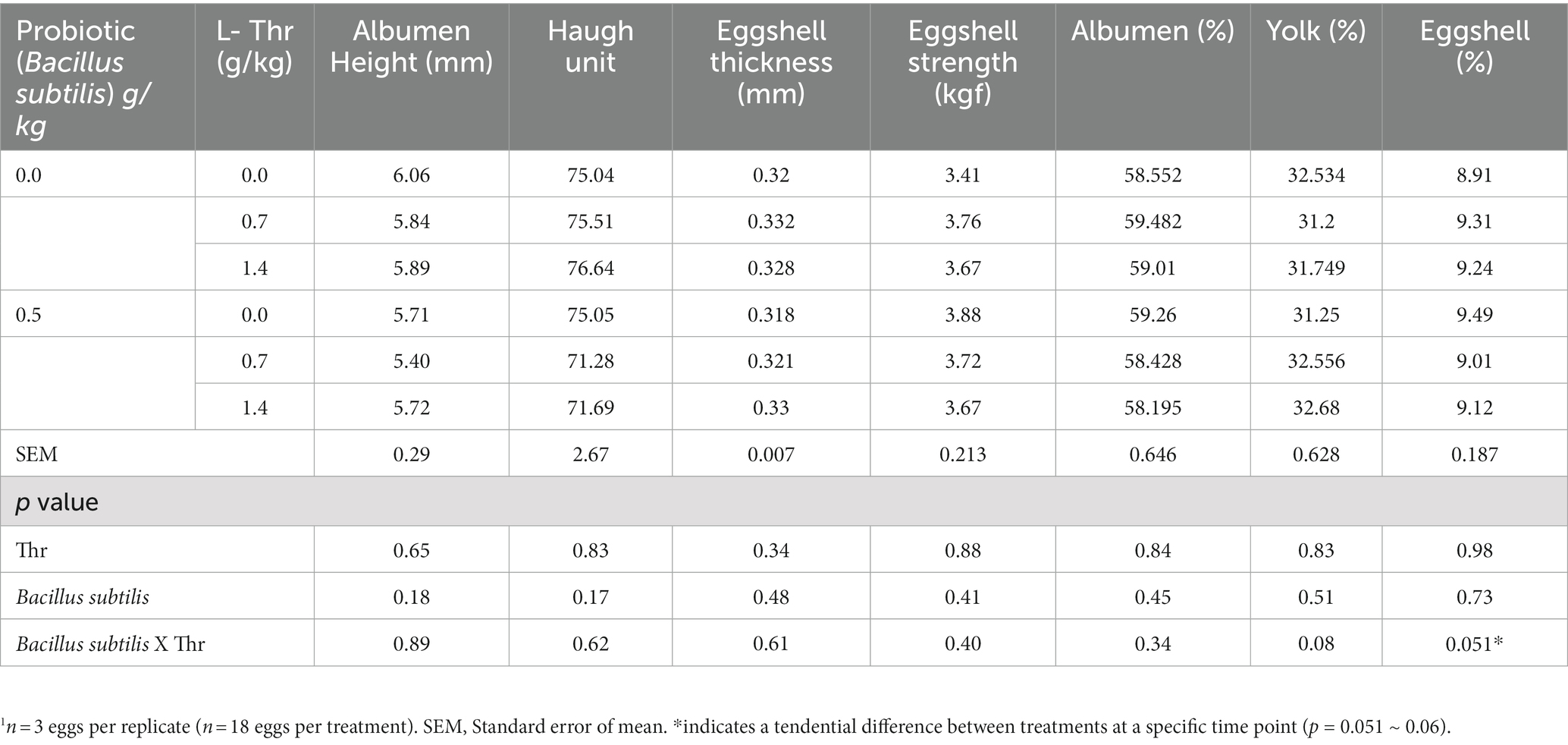
Table 4. Effect of dietary L-Thr levels and Bacillus subtilis addition on egg quality at 48-week-old age.1
The amino acid composition results of egg albumen and yolk are displayed in Tables 5, 6. Except for proline, the addition of B. subtilis decreased (p < 0.05) the concentrations of amino acids in the egg white (albumen). B. subtilis supplementation decreased the concentrations of methionine, isoleucine, valine, and glycine while increasing the concentrations of cysteine, tyrosine, and serine (p < 0.05) in the egg yolk. In contrast, there was no significant influence (p > 0.05) of the dietary L-Thr on the amino acid concentrations in egg albumen and egg yolk.
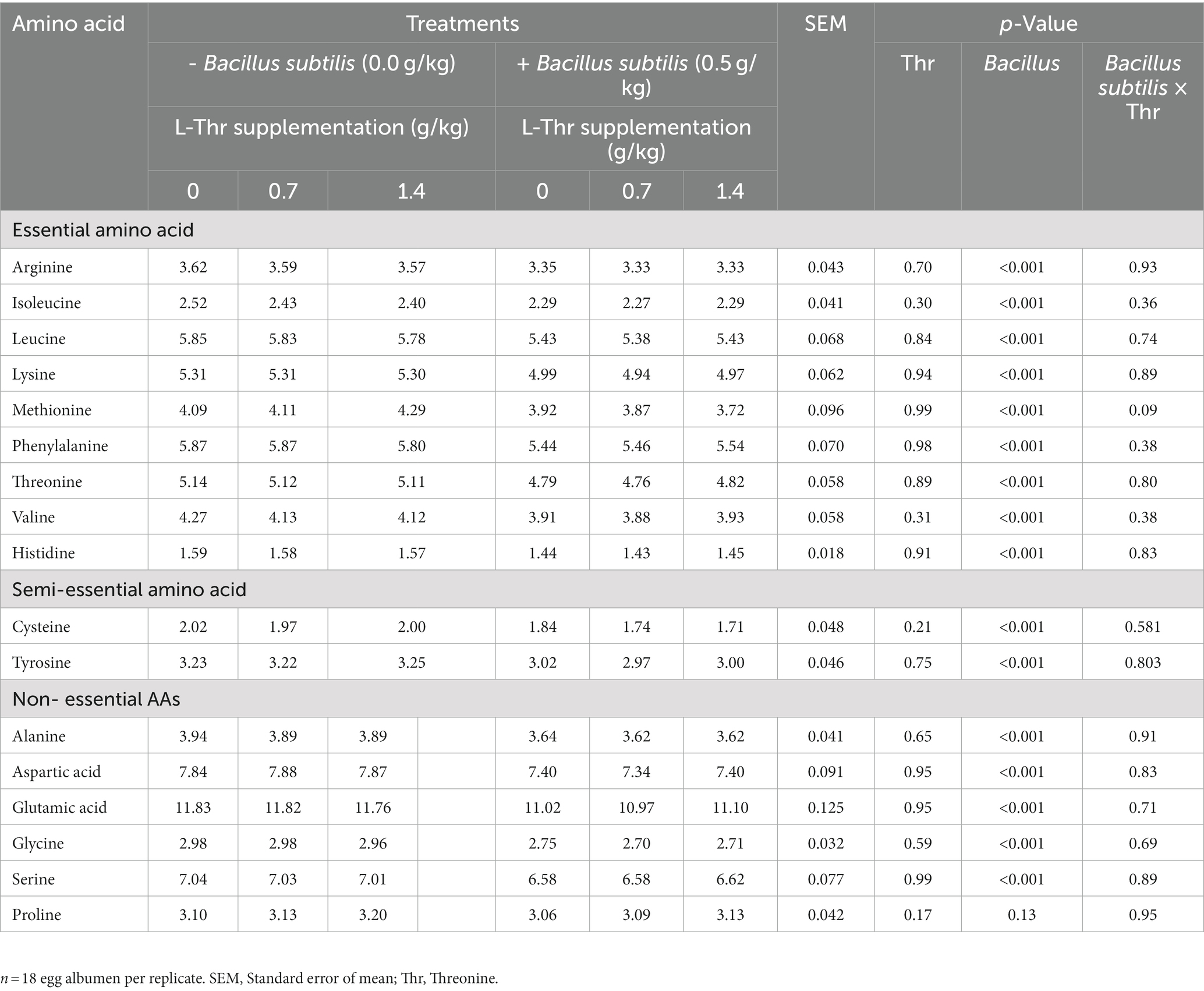
Table 5. Effect of dietary L-Thr levels and Bacillus subtilis addition on amino acid composition (g/100 CP) of albumen in laying duck breeders1.
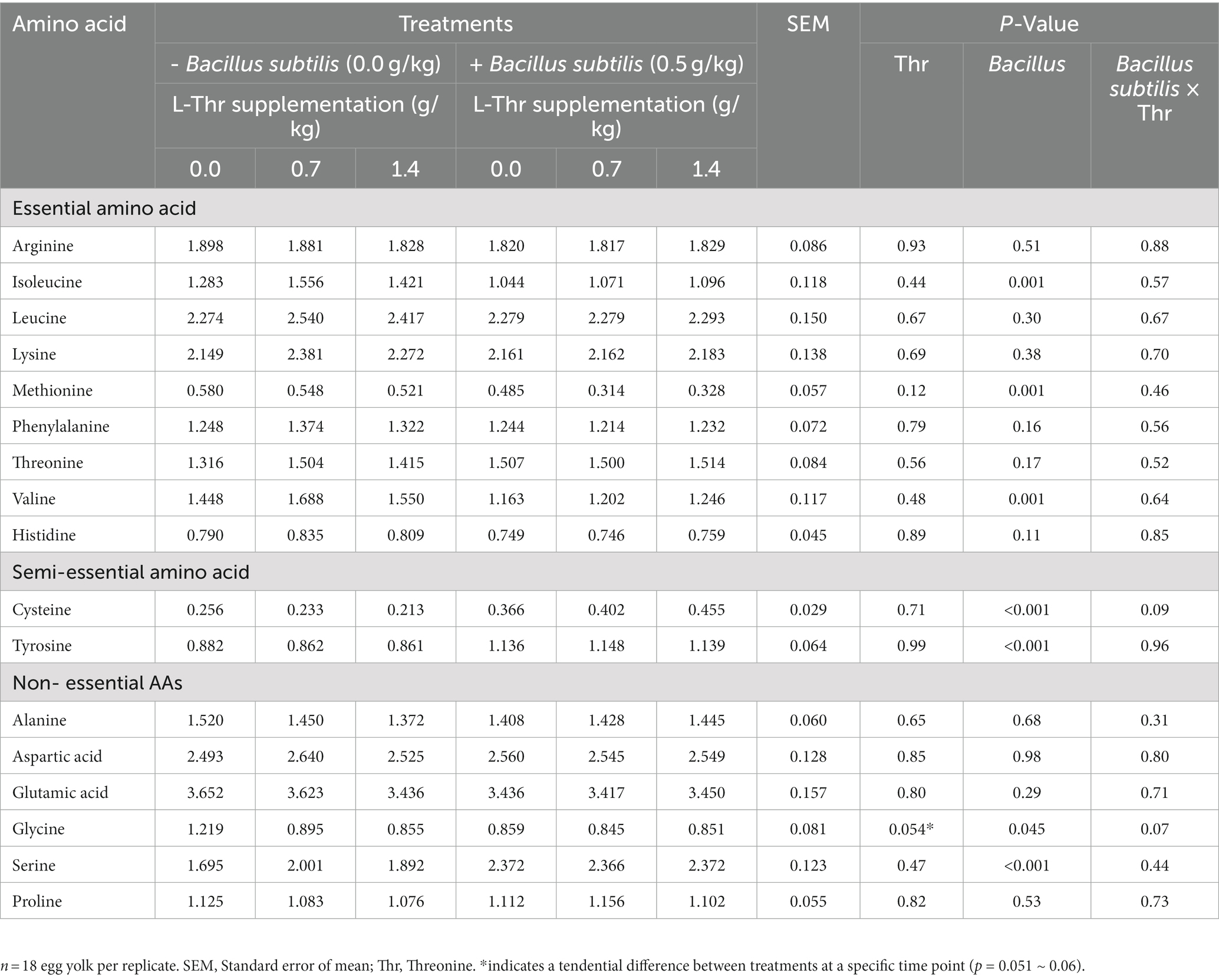
Table 6. Effect of dietary L-Thr levels and Bacillus subtilis addition on amino acid composition (g/100 CP) of yolk in laying duck breeders1.
The results of fertility and hatchability are presented in Table 7. Both Thr and B. subtilis demonstrated no significant effect on the reproductive performance (p > 0.05). The addition of B. subtilis without L-Thr decreased (p < 0.05) the percentage of egg hatchability compared with those of ducks fed diets of Thr at 0.7 and 1.4 g /kg along with dietary B. subtilis (p < 0.001).
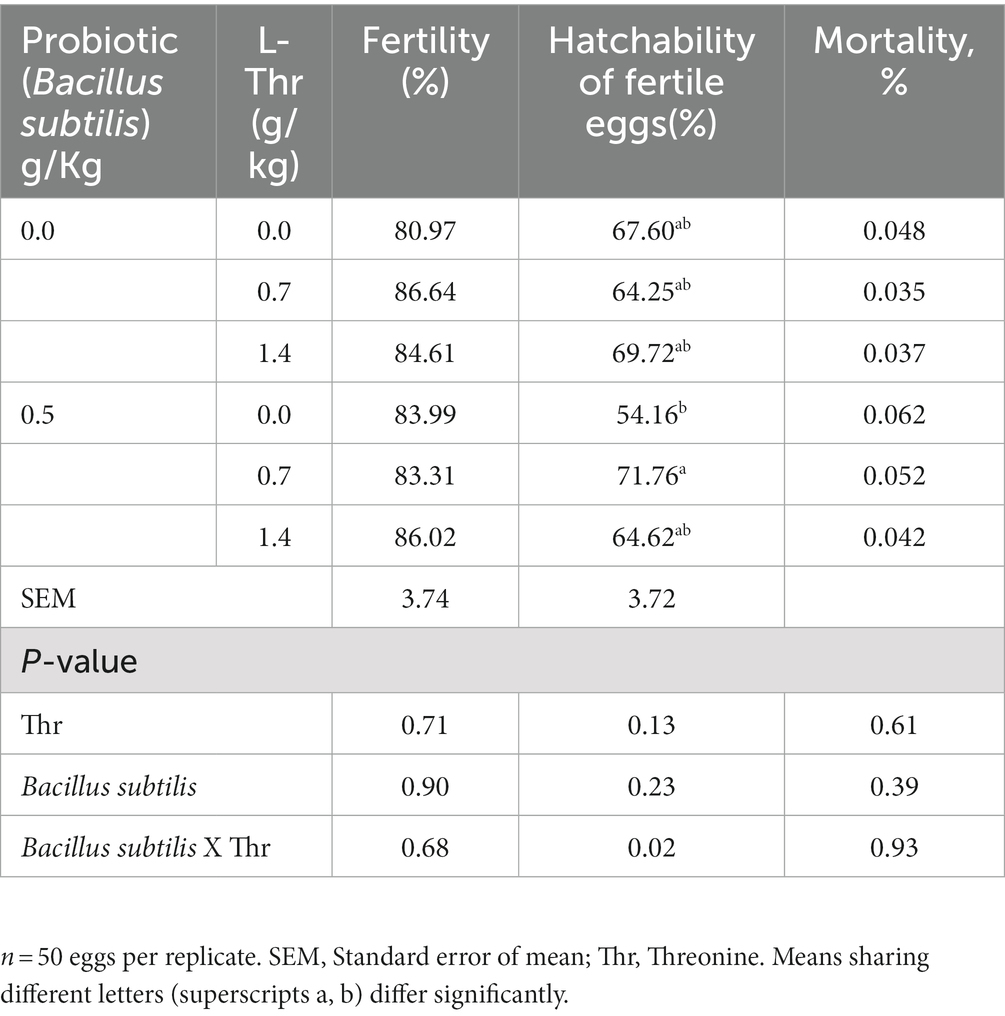
Table 7. Effect of dietary L-Thr levels and Bacillus subtilis addition on fertility and hatchability rate in laying duck breeders.1
The findings of the early growth performance of ducklings are presented in Table 8. Increasing the L-Thr levels increased the hatching weight of ducklings compared with those of birds fed the control diet [33.98 ± 0.054 (0.7 g Thr /kg) and 34.17 ± 0.054 (1.4 g Thr /kg) VS 32.86 ± 0.054 g (0.0 g Thr /kg); p < 0.001]. In addition, the hatching weight of ducklings was higher in birds fed L-Thr supplementation at 1.4 g /kg compared to those of birds fed L-Thr supplementation at 0.7 g /kg (34.17 ± 0.054 vs. 33.98 ± 0.054 g, p < 0.001). In contrast, supplementation of B. subtilis decreased duckling hatching weight (p < 0 0.001). The addition of B. subtilis without L-Thr decreased hatching weight compared with those of ducks fed dietary Thr, along with dietary B. subtilis [31.95 ± 0.072 (0.0 g Thr /kg + 0.5 g B. subtilis /kg) vs. 34.08 ± 0.072 (0.7 g Thr /kg + 0.5 g B. subtilis /kg) and 33.98 ± 0.072 g (1.4 g Thr /kg + 0.5 g B. subtilis /kg); p < 0.001].
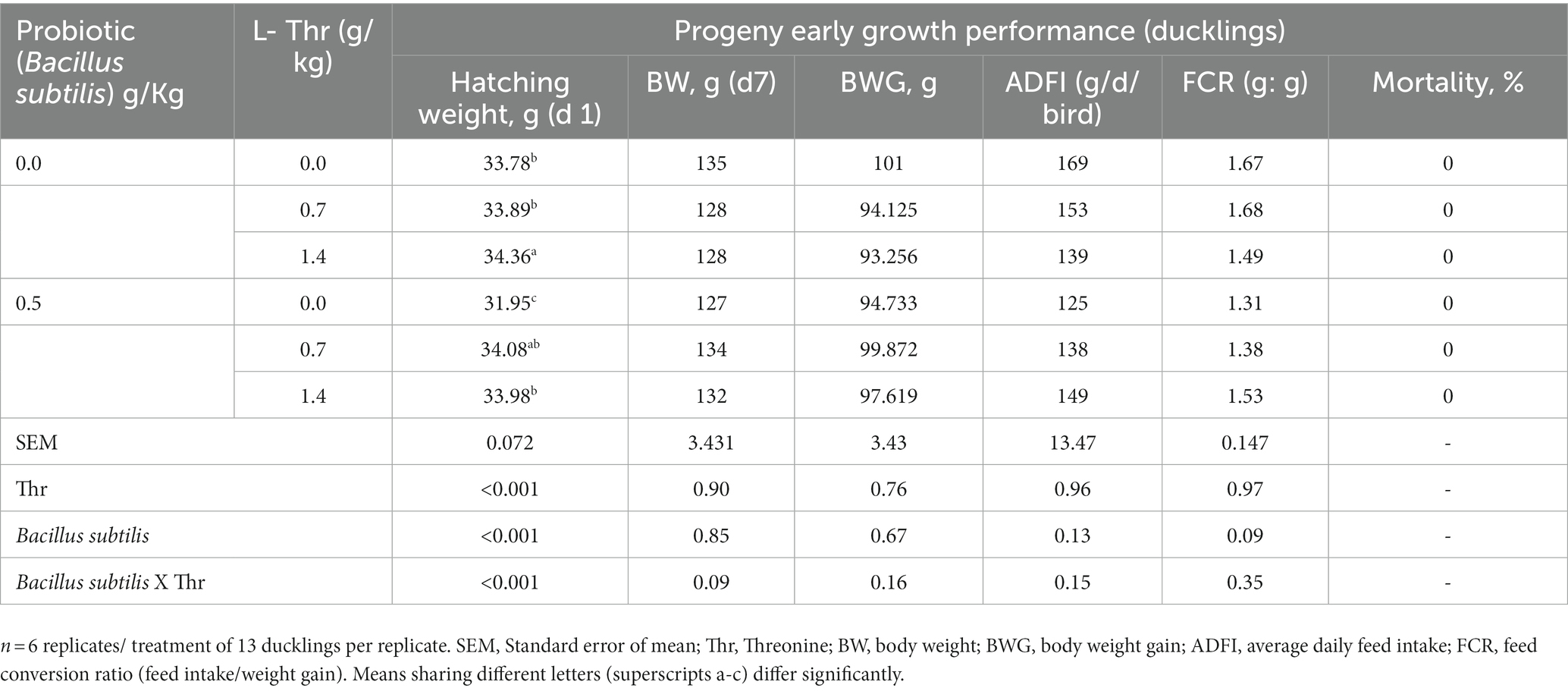
Table 8. Effect of dietary L-Thr levels and Bacillus subtilis addition on early post-hatch performance of ducklings.
According to our knowledge, this is the first study to examine the simultaneous effects of Thr and B. subtilis supplementation on laying duck breeders. Following the restriction of antibiotics as growth promoters in many countries, the use of probiotics or synthetic amino acids in poultry diets has significantly increased (17–20). Previous studies found that a combination of amino acids and probiotics could synergistically or additively compensate to improve production performance, egg quality, and immunity (9). Therefore, we hypothesized that the combination of Thr and B. subtilis DSM32315 may improve the amino acid profile of eggs and the early post-hatch performance of ducklings fed antibiotic-free diets. In the present study, increasing dietary Thr intake improved egg production. It is well known that Thr is an indispensable amino acid because it cannot be synthesized in the body. In laying breeds, it has been reported that increasing dietary Thr level enhanced egg production, egg weight, egg mass, feed conversion ratio, albumen weight, and Haugh units (10, 21). Threonine has been shown to have a beneficial impact on nutrient absorption by augmenting the surface area of the villi (10). This may help to elucidate why the supplementation of Thr has been observed to enhance productive performance. Also, previous studies have reported an improvement in egg production in birds fed probiotics B. subtilis (5, 22, 23). However, in the present study, the addition of B. subtilis did not affect the laying performance. There is a scarcity of experiments on the effect of B. subtilis on laying ducks. Consistent with the findings of the present studies, the prior study revealed that probiotic supplementation (Clostridium butyricum and a combination of Saccharomyces boulardii and Pediococcus acidilactici) (24) or B. subtilis RX7 and B2A supplementation did not impact the laying rate under no stress conditions. Other studies have reported an improvement in egg production in birds fed probiotics B. subtilis (5, 22) under no stress conditions. These contradictory results may be attributed to differences in the addition level, diet composition, species and concentrations of B. subtilis, age of birds, different microorganisms used, and the experiential conditions (25). Since the study was conducted under normal conditions, B. subtilis DSM32315 has no effect on laying performance. Further studies are needed to evaluate the effects of B. subtilis DSM32315 on breeder-laying ducks under different stress conditions.
The current study showed that Thr supplementation had no effects on the egg quality parameters. However, eggshell percentage increased after supplementing a combination of B. subtilis DSM32315 and Thr. Studies have shown that supplementing laying hens with probiotics improves eggshell quality and decreases the number of damaged eggs (26, 27). Inclusion of B. subtilis in hen laying hen diets improved eggshell quality as a result of enhancing calcium absorption (28). Ovalbumin is the predominant protein in albumen; it provides essential amino acids for chicken embryo development and is a valuable source of amino acids required for embryonic development (29). Herein, the addition of B. subtilis decreased methionine, isoleucine, and valine, in the egg albumen and yolk. This finding indicates that B. subtilis may affect essential amino acids and limit their retention and decreasing embryonic growth rates.
In breeding programs and production, the hatchability rate is an essential factor. Intriguingly, the percentage of ducklings that successfully hatched and their hatching weights increased when birds were fed B. subtilis with 0.7 g/kg Thr. Daris et al. (26) suggested that dietary B. subtilis improve eggshell quality, which led to enhance hatchability in broiler breeder hens.
The current study revealed that the combination supplemented of L-Thr and B. subtilis DSM 32315 is recommended due to its positive effects on the eggshell percentage, hatchability and the body weights of newly hatched ducklings when dietary Thr was added at a rate of 0.7 g/kg and B. subtilis DSM 32315 at 0.5 g/kg. In addition, adding L-Thr separately at 0.7 g/kg could improve the egg production of duck breeders. Further studies are required to find the proper dosages of B. subtilis DSM 32315 with co-dietary inclusion of limiting amino acids in the diets of duck breeders. The findings of these trials will support feed additive interventions to transition into antibiotic-free diets.
The raw data supporting the conclusions of this article will be made available by the authors, without undue reservation.
The Animal Care and Use Committee of Guangdong Academy of Agriculture Sciences approved all experimental procedures (GAASIAS-2019-020).
MA and CZ: conceptualization. MA, HE-S and CZ: methodology. MA: investigation and writing–original draft preparation. WX and SW: data curation. YZ, WC, and WX: formal analysis. MA and HE-S: writing–review and editing. CZ: supervision. CZ and MA: funding acquisition. All of the authors contributed to the article and approved the final version.
This study was supported by the China Agriculture Research System of MOF and MARA (Grant No. CARS-42-13), the Modern Agricultural Industry Technology System Innovation Team of Guangdong Province(Grant No. 2019KJ137), the Special Fund for Scientific Innovation Strategy-Construction of High Level Academy of Agricultural Sciences (R2020PY-JX008, 202106TD), and the Science and Technology Program of Guangdong Province (Grant No. 2019A050505007, 2021A0505050003), Foreign Expert Project (QNL20200130001) and Researchers Supporting Project Number (RSPD2023R731), King Saud University (Riyadh, Saudi Arabia).
The authors declare that the research was conducted in the absence of any commercial or financial relationships that could be construed as a potential conflict of interest.
All claims expressed in this article are solely those of the authors and do not necessarily represent those of their affiliated organizations, or those of the publisher, the editors and the reviewers. Any product that may be evaluated in this article, or claim that may be made by its manufacturer, is not guaranteed or endorsed by the publisher.
The Supplementary material for this article can be found online at: https://www.frontiersin.org/articles/10.3389/fvets.2023.1238070/full#supplementary-material
1. Whelan, RA, Doranalli, K, Rinttilä, T, Vienola, K, Jurgens, G, and Apajalahti, J. The impact of Bacillus subtilis DSM 32315 on the pathology, performance, and intestinal microbiome of broiler chickens in a necrotic enteritis challenge. Poult Sci. (2019) 98:3450–63. doi: 10.3382/ps/pey500
2. Sokale, AO, Menconi, A, Mathis, GF, Lumpkins, B, Sims, MD, Whelan, RA, et al. Effect of Bacillus subtilis DSM 32315 on the intestinal structural integrity and growth performance of broiler chickens under necrotic enteritis challenge. Poult Sci. (2019) 98:5392–400. doi: 10.3382/ps/pez368
3. Jha, R, Das, R, Oak, S, and Mishra, P. Probiotics (direct-fed microbials) in poultry nutrition and their effects on nutrient utilization, growth and laying performance, and gut health: a systematic review. Animals. (2020) 10:1–19. doi: 10.3390/ani10101863
4. Bortoluzzi, C, Vieira, BS, Dorigam JC De, P, Menconi, A, Sokale, A, Doranalli, K, et al. Bacillus subtilis dsm 32315 supplementation attenuates the effects of clostridium perfringens challenge on the growth performance and intestinal microbiota of broiler chickens. Microorganisms. (2019) 7:30071. doi: 10.3390/microorganisms7030071
5. Neijat, M, Shirley, RB, Barton, J, Thiery, P, Welsher, A, and Kiarie, E. Effect of dietary supplementation of Bacillus subtilis DSM29784 on hen performance, egg quality indices, and apparent retention of dietary components in laying hens from 19 to 48 weeks of age. Poult Sci. (2019) 98:5622–35. doi: 10.3382/ps/pez324
6. Zou, X, Jiang, S, Zhang, M, Hu, H, Wu, X, Liu, J, et al. Effects of Bacillus subtilis on production performance, bone physiological property and hematology indexes in laying hens. Animals. (2021) 11:2041. doi: 10.3390/ani11072041
7. Liu, X, Peng, C, Qu, X, Guo, S, Chen, JF, He, C, et al. Effects of Bacillus subtilis C-3102 on production, hatching performance, egg quality, serum antioxidant capacity and immune response of laying breeders. J Anim Physiol Anim Nutr (Berl). (2019) 103:182–90. doi: 10.1111/jpn.13022
8. Park, I, Zimmerman, NP, Smith, AH, Rehberger, TG, Lillehoj, EP, and Lillehoj, HS. Dietary supplementation with Bacillus subtilis direct-fed Microbials alters chicken intestinal metabolite levels. Front Vet Sci. (2020) 7:1–9. doi: 10.3389/fvets.2020.00123
9. Casillas-Hernández, R, Gonzalez-Galaviz, JR, Rodriguez-Anaya, LZ, Gil-Núñez, JC, and Rodríguez-Jaramillo M Del, C. Dietary use of methionine sources and Bacillus amyloliquefaciens CECT 5940 influences growth performance, Hepatopancreatic histology, digestion, immunity, and digestive microbiota of Litopenaeus vannamei fed reduced fishmeal diets. Animals. (2023) 13:10043. doi: 10.3390/ani13010043
10. Fouad, AM, Zhang, HX, Chen, W, Xia, WG, Ruan, D, Wang, S, et al. Estimation of L-threonine requirements for Longyan laying ducks. Asian-Australasian. J Anim Sci. (2017) 30:206–10. doi: 10.5713/ajas.16.0235
11. Azzam, MMM, Dong, XY, and Zou, XT. Effect of dietary threonine on laying performance and intestinal immunity of laying hens fed low-crude-protein diets during the peak production period. J Anim Physiol Anim Nutr (Berl). (2017) 101:e55–66. doi: 10.1111/jpn.12559
12. Jiang, S, El-Senousey, HAK, Fan, Q, Lin, X, Gou, Z, Li, L, et al. Effects of dietary threonine supplementation on productivity and expression of genes related to protein deposition and amino acid transportation in breeder hens of yellow-feathered chicken and their offspring. Poult Sci. (2019) 98:6826–36. doi: 10.3382/ps/pez420
13. Sun, M, Jiao, H, Wang, X, Uyanga, VA, Zhao, J, and Lin, H. Encapsulated crystalline lysine and DL-methionine have higher efficiency than the crystalline form in broilers. Poult Sci. (2020) 99:6914–24. doi: 10.1016/j.psj.2020.09.023
14. Ruan, D, Fouad, AM, Zhang, YN, Wang, S, Chen, W, Xia, WG, et al. Effects of dietary lysine on productivity, reproductive performance, protein and lipid metabolism-related gene expression in laying duck breeders. Poult Sci. (2019) 98:5734–45. doi: 10.3382/ps/pez361
15. Latimer, GW. Official methods of analysis of AOAC international. 20th ed. Rockville, MD: AOAC International (2016).
16. Cho, KH, Kang, SW, Yoo, JS, Song, DK, Chung, YH, Kwon, GT, et al. Effects of mealworm (Tenebrio molitor) larvae hydrolysate on nutrient ileal digestibility in growing pigs compared to those of defatted mealworm larvae meal, fermented poultry by-product, and hydrolyzed fish soluble. Asian-Australasian J Anim Sci. (2020) 33:490–500. doi: 10.5713/ajas.19.0793
17. Tang, Q, Tan, P, Ma, N, and Ma, X. Physiological functions of threonine in animals: beyond nutrition metabolism. Nutrients. (2021) 13:2592. doi: 10.3390/nu13082592
18. Rafiq, K, Tofazzal Hossain, M, Ahmed, R, Hasan, MM, Islam, R, Hossen, MI, et al. Role of different growth enhancers as alternative to in-feed antibiotics in poultry industry. Front Vet Sci. (2022) 8:1–9. doi: 10.3389/fvets.2021.794588
19. Wang, J, Ishfaq, M, Guo, Y, Chen, C, and Li, J. Assessment of probiotic properties of Lactobacillus salivarius isolated from chickens as feed additives. Front Vet Sci. (2020) 7:1–12. doi: 10.3389/fvets.2020.00415
20. Montout, L, Poullet, N, and Bambou, JC. Systematic review of the interaction between nutrition and immunity in livestock: effect of dietary supplementation with synthetic amino acids. Animals. (2021) 11:2813. doi: 10.3390/ani11102813
21. Azzam, MMM, Dong, XY, Xie, P, Wang, C, and Zou, XT. The effect of supplemental L-threonine on laying performance, serum free amino acids, and immune function of laying hens under high-temperature and high-humidity environmental climates. J Appl Poult Res. (2011) 20:361–70. doi: 10.3382/japr.2010-00308
22. Abdelqader, A, Al-Fataftah, AR, and Daş, G. Effects of dietary Bacillus subtilis and inulin supplementation on performance, eggshell quality, intestinal morphology and microflora composition of laying hens in the late phase of production. Anim Feed Sci Technol. (2013) 179:103–11. doi: 10.1016/J.ANIFEEDSCI.2012.11.003
23. Wang, Y, Wang, H, Wang, B, Zhang, B, and Li, W. Effects of manganese and Bacillus subtilis on the reproductive performance, egg quality, antioxidant capacity, and gut microbiota of breeding geese during laying period. Poult Sci. (2020) 99:6196–204. doi: 10.1016/j.psj.2020.08.012
24. Xiang, Q, Wang, C, Zhang, H, Lai, W, Wei, H, and Peng, J. Effects of different probiotics on laying performance, egg quality, oxidative status, and gut health in laying hens. Animals. (2019) 9:1110. doi: 10.3390/ani9121110
25. Shi, H, Lin Zhang, W, and Ho, KI. Effects of dietary Bacillus subtilis RX7 and B2A supplementation on productive performance, egg quality, blood profiles, and excreta salmonella counts in laying hens. Can J Anim Sci. (2020) 100:411–7. doi: 10.1139/cjas-2019-0064
26. Darsi, E, and Zhaghari, M. Effects of Bacillus subtilis PB6 supplementation on productive performance, egg quality and hatchability in broiler breeder hens under commercial farm condition. J Appl Anim Res. (2021) 49:109–17. doi: 10.1080/09712119.2021.1893738
27. Fathi, M, Al-Homidan, I, Al-Dokhail, A, Ebeid, T, Abou-Emera, O, and Alsagan, A. Effects of dietary probiotic (Bacillus subtilis) supplementation on productive performance, immune response and egg quality characteristics in laying hens under high ambient temperature. Ital J Anim Sci. (2018) 17:804–14. doi: 10.1080/1828051X.2018.1425104
28. Wang, J, Wei, WW, Hai, QG, Fei, CC, Geng, WS, Jun, ZH, et al. Effects of dietary Bacillus subtilis supplementation and calcium levels on performance and eggshell quality of laying hens in the late phase of production. Poult Sci. (2021) 100:100970:1–10. doi: 10.1016/j.psj.2020.12.067
Keywords: ducks, Threonine, Bacillus subtilis, amino acid composition of eggs, hatch weight of ducklings
Citation: Azzam MM, Chen W, Xia W, Wang S, Zhang Y, El-Senousey HK and Zheng C (2023) The impact of Bacillus subtilis DSM32315 and L-Threonine supplementation on the amino acid composition of eggs and early post-hatch performance of ducklings. Front. Vet. Sci. 10:1238070. doi: 10.3389/fvets.2023.1238070
Received: 10 June 2023; Accepted: 10 August 2023;
Published: 23 August 2023.
Edited by:
Abdel-Moneim Eid Abdel-Moneim, Egyptian Atomic Energy Authority, EgyptReviewed by:
Jiashun Chen, Hunan Agricultural University, ChinaCopyright © 2023 Azzam, Chen, Xia, Wang, Zhang, El-Senousey and Zheng. This is an open-access article distributed under the terms of the Creative Commons Attribution License (CC BY). The use, distribution or reproduction in other forums is permitted, provided the original author(s) and the copyright owner(s) are credited and that the original publication in this journal is cited, in accordance with accepted academic practice. No use, distribution or reproduction is permitted which does not comply with these terms.
*Correspondence: Chuntian Zheng, emhlbmdjaHVudGlhbkBnZGFhcy5jbg==
Disclaimer: All claims expressed in this article are solely those of the authors and do not necessarily represent those of their affiliated organizations, or those of the publisher, the editors and the reviewers. Any product that may be evaluated in this article or claim that may be made by its manufacturer is not guaranteed or endorsed by the publisher.
Research integrity at Frontiers

Learn more about the work of our research integrity team to safeguard the quality of each article we publish.